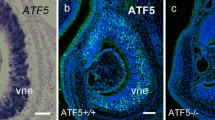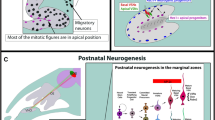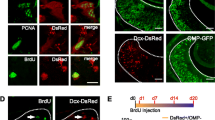Abstract
The differentiation of sensory neurons involves gene expression changes induced by specific transcription factors. Vomeronasal sensory neurons (VSNs) in the mouse vomeronasal organ (VNO) consist of two major subpopulations of neurons expressing vomeronasal 1 receptor (V1r)/Gαi2 or vomeronasal 2 receptor (V2r)/Gαo, which differentiate from a common neural progenitor. We previously demonstrated that the differentiation and survival of VSNs were inhibited in ATF5 transcription factor-deficient mice (Nakano et al. Cell Tissue Res 363:621–633, 2016). These defects were more prominent in V2r/Gαo-type than in V1r/Gαi2-type VSNs; however, the molecular mechanisms responsible for the differentiation of V2r/Gαo-type VSNs by ATF5 remain unclear. To identify a cofactor involved in ATF5-regulated VSN differentiation, we investigated the expression and function of CCAAT/enhancer-binding protein gamma (C/EBPγ, Cebpg), which is a major C/EBP family member expressed in the mouse VNO and dimerizes with ATF5. The results obtained showed that C/EBPγ mRNAs and proteins were broadly expressed in the postmitotic VSNs of the neonatal VNO, and their expression decreased by the second postnatal week. The C/EBPγ protein was expressed in the nuclei of approximately 70% of VSNs in the neonatal VNO, and 20% of the total VSNs co-expressed C/EBPγ and ATF5 proteins. We examined the trans-acting effects of C/EBPγ and ATF5 on V2r transcription and found that the co-expression of C/EBPγ and ATF5, but not C/EBPγ or ATF5 alone, increased Vmn2r66 promoter reporter activity via the C/EBP:ATF response element (CARE) in Neuro2a cells. These results suggest the role of C/EBPγ on ATF5-regulated VSN differentiation in early postnatal development.





Similar content being viewed by others
References
Barber PC, Raisman G (1978) Cell division in the vomeronasal organ of the adult mouse. Brain Res 141:57–66
Berghard A, Buck LB (1996) Sensory transduction in vomeronasal neurons: evidence for G alpha o, G alpha i2, and adenylyl cyclase II as major components of a pheromone signaling cascade. J Neurosci 16:909–918
Brann JH, Firestein S (2010) Regeneration of new neurons is preserved in aged vomeronasal epithelia. J Neurosci 30:15686–15694
Cau E, Gradwohl G, Fode C, Guillemot F (1997) Mash1 activates a cascade of bHLH regulators in olfactory neuron progenitors. Development 124:1611–1621
Chang I, Parrilla M (2016) Expression patterns of homeobox genes in the mouse vomeronasal organ at postnatal stages. Gene Expr Patterns 21:69–80
Cooper C, Henderson A, Artandi S, Avitahl N, Calame K (1995) Ig/EBP (C/EBPγ) is a transdominant negative inhibitor of C/EBP family transcriptional activators. Nucleic Acids Res 23:4371–4377
Cuschieri A, Bannister LH (1975) The development of the olfactory mucosa in the mouse: light microscopy. J Anat 119:277–286
Dalton RP (2018) Shared genetic requirements for ATF5 translation in the vomeronasal organ and main olfactory epithelium [version 1; referees: awaiting peer review]. F1000Research 7:73. https://doi.org/10.12688/f1000research.13659.1)
Dalton RP, Lyons DB, Lomvardas S (2013) Co-opting the unfolded protein response to elicit olfactory receptor feedback. Cell 155:321–332
De La Rosa-Prieto C, Saiz-Sanchez D, Ubeda-Banon I, Argandona-Palacios L, Garcia-Munozguren S, Martinez-Marcos A (2010) Neurogenesis in subclasses of vomeronasal sensory neurons in adult mice. Dev Neurobiol 70:961–970
Dulac C, Axel R (1995) A novel family of genes encoding putative pheromone receptors in mammals. Cell 83:195–206
Enomoto T, Ohmoto M, Iwata T, Uno A, Saitou M, Yamaguchi T, Kominami R, Matsumoto I, Hirota J (2011) Bcl11b/Ctip2 controls the differentiation of vomeronasal sensory neurons in mice. J Neurosci 31:10159–10173
Garrosa M, Coca S (1991) Postnatal development of the vomeronasal epithelium in rat: an ultrastructural study. J Morphol 208:257–269
Giacobini P, Benedetto A, Tirindelli R, Fasolo A (2000) Proliferation and migration of receptor neurons in the vomeronasal organ of the adult mouse. Dev Brain Res 123:33–40
Hatano M, Umemura M, Kimura N, Yamazaki T, Takeda H, Nakano H, Takahashi S, Takahashi Y (2013) The 5′-untranslated region regulates ATF5 mRNA stability via nonsense-mediated mRNA decay in response to environmental stress. FEBS J 280:4693–4707
Herrada G, Dulac C (1997) A novel family of putative pheromone receptors in mammals with a topographically organized and sexually dimorphic distribution. Cell 90:763–773
Huggins CJ, Mayekar MK, Martin N, Saylor KL, Gonit M, Jailwala P, Kasoji M, Haines DC, Quinones OA, Johnson PF (2016) C/EBPγ is a critical regulator of cellular stress response networks through heterodimerization with ATF4. Mol Cell Biol 36:693–713
Ibarra-Soria X, Levitin MO, Saraiva LR, Logan DW (2014) The olfactory transcriptomes of mice. PLoS Genet 10:e1004593
Jia C, Halpern M (1996) Subclasses of vomeronasal receptor neurons: differential expression of G proteins (Gi alpha 2 and G(o alpha)) and segregated projections to the accessory olfactory bulb. Brain Res 719:117–128
Juliana CA, Yang J, Rozo AV, Good A, Groff DN, Wang SZ, Green MR, Stoffers DA (2017) ATF5 regulates β-cell survival during stress. Proc Natl Acad Sci U S A 114:1341–1346
Kaisho T, Tsutsui H, Tanaka T, Tsujimura T, Takeda K, Kawai T, Yoshida N, Nakanishi K, Akira S (1999) Impairment of natural killer cytotoxic activity and interferon gamma production in CCAAT/enhancer binding protein gamma-deficient mice. J Exp Med 190:1573–1582
Khan A, Fornes O, Stigliani A, Gheorghe M, Castro-Mondragon JA, van der Lee R, Bessy A, Cheneby J, Kulkarni SR, Tan G, Baranasic D, Arenillas DJ, Sandelin A, Vandepoele K, Lenhard B, Ballester B, Wasserman WW, Parcy F, Mathelier A (2018) JASPAR 2018: update of the open-access database of transcription factor binding profiles and its web framework. Nucleic Acids Res 46:D260–D266
Liberles SD (2014) Mammalian pheromones. Annu Rev Physiol 76:151–175
Lin JM, Taroc EZM, Frias JA, Prasad A, Catizone AN, Sammons MA, Forni PE (2018) The transcription factor Tfap2e/AP-2ε plays a pivotal role in maintaining the identity of basal vomeronasal sensory neurons. Dev Biol 441:67–82
Martinez-Marcos A, Jia C, Quan W, Halpern M (2005) Neurogenesis, migration, and apoptosis in the vomeronasal epithelium of adult mice. J Neurobiol 63:173–187
Matsunami H, Buck LB (1997) A multigene family encoding a diverse array of putative pheromone receptors in mammals. Cell 90:775–784
Murray RC, Navi D, Fesenko J, Lander AD, Calof AL (2003) Widespread defects in the primary olfactory pathway caused by loss of Mash1 function. J Neurosci 23:1769–1780
Nakano H, Iida Y, Suzuki M, Aoki M, Umemura M, Takahashi S, Takahashi Y (2016) Activating transcription factor 5 (ATF5) is essential for the maturation and survival of mouse basal vomeronasal sensory neurons. Cell Tissue Res 363:621–633
Newman JR, Keating AE (2003) Comprehensive identification of human bZIP interactions with coiled-coil arrays. Science 300:2097–2101
Nishizawa M, Nagata S (1992) cDNA clones encoding leucine-zipper proteins which interact with G-CSF gene promoter element 1-binding protein. FEBS Lett 299:36–38
Oboti L, Ibarra-Soria X, Perez-Gomez A, Schmid A, Pyrski M, Paschek N, Kircher S, Logan DW, Leinders-Zufall T, Zufall F, Chamero P (2015) Pregnancy and estrogen enhance neural progenitor-cell proliferation in the vomeronasal sensory epithelium. BMC Biol 13:104
Prince JE, Brignall AC, Cutforth T, Shen K, Cloutier JF (2013) Kirrel3 is required for the coalescence of vomeronasal sensory neuron axons into glomeruli and for male-male aggression. Development 140:2398–2408
Ryba NJ, Tirindelli R (1997) A new multigene family of putative pheromone receptors. Neuron 19:371–379
Shimizu YI, Morita M, Ohmi A, Aoyagi S, Ebihara H, Tonaki D, Horino Y, Iijima M, Hirose H, Takahashi S, Takahashi Y (2009) Fasting induced up-regulation of activating transcription factor 5 in mouse liver. Life Sci 84:894–902
Simmons DG, Natale DR, Begay V, Hughes M, Leutz A, Cross JC (2008) Early patterning of the chorion leads to the trilaminar trophoblast cell structure in the placental labyrinth. Development 135:2083–2091
Suzuki Y, Mizoguchi I, Nishiyama H, Takeda M, Obara N (2003) Expression of Hes6 and NeuroD in the olfactory epithelium, vomeronasal organ and non-sensory patches. Chem Senses 28:197–205
Umemura M, Tsunematsu K, Shimizu YI, Nakano H, Takahashi S, Higashiura Y, Okabe M, Takahashi Y (2015) Activating transcription factor 5 is required for mouse olfactory bulb development via interneuron. Biosci Biotechnol Biochem 79:1082–1089
Vinson CR, Hai T, Boyd SM (1993) Dimerization specificity of the leucine zipper-containing bZIP motif on DNA binding: prediction and rational design. Genes Dev 7:1047–1058
Wakabayashi Y, Ichikawa M (2007) Distribution of Notch1-expressing cells and proliferating cells in mouse vomeronasal organ. Neurosci Lett 411:217–221
Wang SZ, Ou J, Zhu LJ, Green MR (2012) Transcription factor ATF5 is required for terminal differentiation and survival of olfactory sensory neurons. Proc Natl Acad Sci U S A 109:18589–18594
Watatani Y, Ichikawa K, Nakanishi N, Fujimoto M, Takeda H, Kimura N, Hirose H, Takahashi S, Takahashi Y (2008) Stress-induced translation of ATF5 mRNA is regulated by the 5′-untranslated region. J Biol Chem 283:2543–2553
Weiler E, McCulloch MA, Farbman AI (1999) Proliferation in the vomeronasal organ of the rat during postnatal development. Eur J Neurosci 11:700–711
Zhao Y, Zhang YD, Zhang YY, Qian SW, Zhang ZC, Li SF, Guo L, Liu Y, Wen B, Lei QY, Tang QQ, Li X (2014) p300-dependent acetylation of activating transcription factor 5 enhances C/EBPβ transactivation of C/EBPα during 3T3-L1 differentiation. Mol Cell Biol 34:315–324
Zhou D, Palam LR, Jiang L, Narasimhan J, Staschke KA, Wek RC (2008) Phosphorylation of eIF2 directs ATF5 translational control in response to diverse stress conditions. J Biol Chem 283:7064–7073
Acknowledgments
We thank the members of the Takahashi laboratory for their support and useful discussions.
Author information
Authors and Affiliations
Corresponding author
Ethics declarations
All mouse studies were approved by the Institutional Animal Experiment Committee of the university and were performed in accordance with institutional and governmental guidelines.
Additional information
Publisher’s note
Springer Nature remains neutral with regard to jurisdictional claims in published maps and institutional affiliations.
Electronic supplementary material
Supplemental Fig. S1
(PDF 7002 kb)
Supplemental Fig. S2
(PDF 332 kb)
Supplemental Fig. S3
(PDF 306 kb)
Supplemental Table S1
(PDF 164 kb)
Rights and permissions
About this article
Cite this article
Nakano, H., Iida, Y., Murase, T. et al. Co-expression of C/EBPγ and ATF5 in mouse vomeronasal sensory neurons during early postnatal development. Cell Tissue Res 378, 427–440 (2019). https://doi.org/10.1007/s00441-019-03070-2
Received:
Accepted:
Published:
Issue Date:
DOI: https://doi.org/10.1007/s00441-019-03070-2




